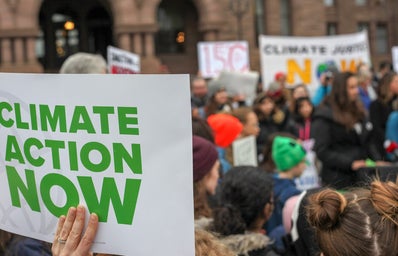In December 2015, the UN promoted a conference in Paris, known as COP21, to discuss climate changes. At the end of it, almost 200 countries signed the Paris Agreement. The document intended to reduce global warming, by limiting the temperature increase to below 2°C — preferably, 1.5°C —, comparing to the pre-industrial period. It was the first universal agreement with such goals, which makes it so notorious.
The Paris Agreement became effective almost one year later, in November 2016. It was established that the parties would meet again every five years, to keep track of progress. It was decided that if a country reaches its goals — called Nationally Determined Contributions (NDCs) —, it should establish new, more ambitious ones.
The accord understands that the developing countries will take longer to reach the peak of greenhouse gas emissions. That is why it sets that more developed ones should compromise to support developing nations financially and technologically.
In 2018, at the COP24, the parties set a detailed plan of action, aiming to make the goals reachable. In 2020, the Paris Agreement substituted the Kyoto Protocol.
- Greenhouse effect and global warming
-
The greenhouse effect is vital for life on Earth. The so-called greenhouse gases — such as CO2, CH4, N2O, CFCs, and O3 — create a layer around our planet. When the radiation from the sun achieves the surface, it is reflected. However, that layer blocks part of it, preventing it from going away, so that it stays on the surface and elevates the temperature, just like in a greenhouse. That is why we can have life as we know it on our planet.
However, there is a problem with that: since the Industrial Revolution, humans have been liberating a huge amount of greenhouse gases from the atmosphere, so the layer around the planet is growing. That way, a bigger portion of the radiation remains on the surface, which increases global temperature more than necessary. That is what we call global warming.
Global warming is dangerous because it has a series of consequences that jeopardize life on Earth. For example, it makes the glaciers melt, threatening animals that depend on them to survive and elevating sea levels. That can destroy coastal ecosystems and cause meteorological changes, resulting in the extinction of species and environmental imbalance.
- Strategies
-
The main goal of the Paris Agreement is to mitigate global warming and minimize its impacts both on developed and developing countries. With that in mind, it is necessary to reduce and prevent greenhouse gas emissions.
The main sources of those emissions are the burning of forests and fossil fuels, such as gasoline and diesel. Industries have a significant role in them, as well. Also, cattle raising is responsible for a great amount of CH4 liberation.
One way to reduce emissions is to invest in clean and renewable energy sources, such as hydroelectric and wind energy. It is fundamental to stop burnings and deforestation and start reforesting damaged areas since plants are responsible for absorbing CO2 and producing oxygen.
It is important to remind that, for the Paris Agreement to be efficient, not only the country’s governments have to collaborate — there must be cooperation among civil society, the private sector, financial institutions, cities, and communities. That is why the parties have agreed to adopt a transparency policy, reporting their actions to their people and the world.
- United States and Brazil
-
In 2017, the now-former president of the US, Donald Trump, withdrew the country from the Paris Agreement. The politician was in denial and cynical about climate change. The event had an international repercussion, not only because the US is a global leader and was the only party to leave the agreement, but because it is the second-biggest emitter of greenhouse gases, behind China.
The nation’s withdraw could elevate the global temperature to 0.3°C. Fortunately, in 2021, the current president Joe Biden made the US rejoin the Paris Agreement, to eliminate North American emissions until 2050.
Brazil, in its turn, runs counter to the goals of the Paris Agreement. Although, in 2015, it promised to reduce its emissions by 37% until 2025 (comparing with the levels of 2005), the policies adopted by the current president, Jair Bolsonaro, don’t go that way. Since 2017, illegal deforestation is the first cause of emissions, followed by agriculture and cattle raising.
Deforestation keeps growing in Amazônia, the world’s biggest rainforest, and there are no governmental measures to stop that. That is one of the reasons why many countries keep pressuring the Brazilian government to do something against it: it is a problem that affects the whole world.
- What the future holds
-
Studies show that greenhouse gas emissions are still increasing. On the other hand, scientists say that to really keep global warming under control, the emissions must drop by 50% until 2030 — that is, in less than a decade. The skepticism about science that the Covid-19 pandemic has shown makes some specialists feel pessimistic.
Now, more than ever, it is important to educate society, so that it can demand environment-friendly policies from their governments. The planet is all we’ve got.
———————————————————————————
The article above was edited by Julia Queiroz.
Liked this type of content? Check Her Campus Casper Libero’s home page for more!


